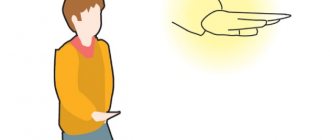- February 22, 2020
- Dogs and hunting with them
- Evdokimova Irina
Many novice owners do not know how to punish a puppy for disobedience. But the proper upbringing of a dog largely depends on this. Sometimes people are lenient about petty pranks and aggression in puppies. As a result, a spoiled and uncontrollable dog grows up in the house, which is very difficult to cope with. Experienced dog handlers believe that it is impossible to do without punishment in raising animals. In this article we will talk about acceptable and unacceptable actions towards a pet.
Features of dog psychology
Before punishing a puppy for disobedience, the owner needs to thoroughly study the peculiarities of the dog’s psychology. By nature, these animals are quite docile. Submission to the leader is genetically inherent in them.
The psyche of a dog is quite simple. Animals are incapable of complex thought processes, but they have a good understanding of cause-and-effect relationships. If the puppy's bad actions are immediately followed by punishment (negative reinforcement), and good actions are immediately followed by reward, then the pet will learn the correct forms of behavior. This is what the training process is based on.
Every owner should learn how to properly punish a puppy for disobedience. You should not act under the influence of a bad mood or give in to anger. This can lead to dire consequences.
Experts believe that dogs are not capable of revenge. But unfair or cruel punishment remains in the animal’s memory. This can lead to the formation of undesirable character traits: anger, aggressiveness or cowardice. Therefore, when punishing a puppy, you need to act carefully and carefully.
Second way
In each city there are specially built areas for walking and training dogs, where you can train together with other dog breeders under the guidance of a professional trainer.
This method is quite effective if there are not very many animals on the site at the same time. Otherwise, they will be distracted and interfere with each other's commands. Some dog handlers claim that dogs tend to imitate. No studies have been conducted on this claim, so it is impossible to say for sure whether this is actually true. However, dog owners claim that their pets learn science faster if they have a positive example in front of them.
Is it possible to punish a dog in front of others? Certainly! By inducing a feeling of shame in the dog, you can be sure that the offense for which he was reprimanded will not be repeated.
How to gain authority from your pet
The ancestors of dogs lived in packs and obeyed leaders. For successful training, it is very important for a person to gain authority from a pet. The owner needs to act as a leader.
When a puppy gets into a family, he looks for his place in the hierarchy of the pack. It is very important for the owner to assert his dominance from the first days, otherwise the dog will grow up disobedient. To gain authority from the very beginning with your pet, you need to show a lot of attention and care. It is necessary to regularly walk with the puppy, talk to him and reward him with treats for good behavior. The dog recognizes the leadership of the person who cares about it.
Sometimes owners ignore the puppy’s misbehavior. This undermines their authority and leads to persistent disobedience of the pet. The dog must be strictly prohibited from doing the following:
- sleep without permission in the owner's bed;
- jump on beds, chairs and sofas;
- steal food from the table;
- bite;
- break free and try to escape while walking.
You should teach your puppy daily simple commands, such as “Give me a paw” or “Sit.” This will help the owner maintain his leadership and authority.
Basic Techniques
"Come to me" command. Ideally, your dog should run towards you on command. It is much easier to control a pet who is fluent in this command. As a rule, few people have problems during the learning process. Conduct regular training
In addition, you need to pay attention not only to the fact of why the pet does not want to stay in the yard, but also to train it not to do so. Regular exercise will tire the dog and it will not want to waste energy. Sterilization
Neutered dogs are less likely to travel and are also not attracted to members of the opposite sex. On the other hand, you have the need to monitor interactions with other dogs. Install a fence. Give your pet enough space to move around without worry. If you decide to install a fence, you need to make it high enough so that the dog cannot jump over it. You also need to cement the foundation so that it does not undermine. If you do not want to resort to such a measure, then periodically check to see if your four-legged friend has gone on a journey. Always work on your pet's behavior. Your responsibility during a walk is to explain to him in an understandable way what he can do and what he cannot do. If you have not done this, keep the animal on a leash. Also, include your number and home address on the collar. If you're lucky, if you lose it, caring people will return your pet. After it has been returned to you, do not scold it, but rather praise it and give it something tasty. If you encourage him to return, then sooner or later he will understand that this place is his home. Enjoy spending time together with your pet. For many, dogs are good friends who take owners on various adventures. In addition, arrange your yard so that the animal is not interested in leaving its confines. Train his behavior, encourage obedience with delicious food. Also buy him toys so that he can chew and fiddle with them. Add variety to your dog's life. Very often they become bored with backyards, so they may run away to explore a new area. Take your pet for rides in the car, if possible, and take them to parks and training grounds.
You need to create conditions that will ensure that the pet does not go on wanderings.
Punishment time
The owner needs to not only know how to punish a puppy for disobedience, but also select the right time for negative reinforcement. It's a common mistake new pet owners often make. They begin to scold the puppy a few hours after the offense has been committed.
Dogs do not have developed logical thinking. If punishment is delayed, they cannot make the connection between their behavior and the negative reinforcement. In such cases, the pet does not understand why the owner is scolding him.
Therefore, an animal must be punished when it commits an undesirable act. Dogs have well-developed cause-and-effect thinking. Punishment must be immediate and follow the wrong behavior. Only in this case will the pet be able to understand what actions he needs to avoid.
The owner’s behavior after punishment also plays an important role in raising a dog. In the first few hours, you need to limit communication with your pet, games and treats. The puppy should feel that the owner is dissatisfied with his actions.
It is also necessary to stop negative reinforcement in a timely manner. If the dog realizes his guilt and obeys, then the punishment cannot be continued. Otherwise, this may lead to an outbreak of aggression in the pet.
Briefly about the main thing
- Punishment, or negative reinforcement, is an important part of education and training.
- The reaction to aggression, damaged things and disobedience must be immediate.
- The main methods of punishment: severe reprimand, ignoring, shaking the withers.
- Even if a dog exhibits destructive behavior, it should not be beaten, starved, or deprived of companionship for a long time.
- Due to their developmental characteristics, puppies can relieve themselves in the house and chew on objects. With the right approach, this behavior goes away by 4-6 months.
Punishment is one of the most difficult aspects of raising a dog. Share your proven methods in the comments.
Rebuke
Verbal reprimand is the safest method. Many dogs respond to voice intonation and understand when their owner is reprimanding them for something wrong. But at the same time, it is important to know how to punish a puppy for disobedience, using only words. Wrong actions can provoke aggression in your pet.
During the reprimand process, you must adhere to the following algorithm of actions:
- Make a stern facial expression.
- Bend over slightly and look your pet in the eyes.
- In a calm but stern voice, say phrases such as “Ugh,” “Bad dog,” or “No.”
After verbal punishment, you need to deprive the dog of communication with the owner and long walks for a short time.
You should not shout at the puppy or wave your hands in front of him. Otherwise, the dog may bite the owner. Verbal reprimand should not last long. After all, dogs don’t understand long monologues. They are able to perceive only a very limited number of words. Therefore, you need to limit yourself to short and clear commands.
When to punish
Many amateur dog breeders make the grave mistake of punishing their pets for an offense several hours have passed since it was committed. If you were at work and didn’t see your pet shitting on the sofa or chewing on it, then you don’t need to take a belt and carry out educational measures. A dog can only remember events for a couple of hours. If you punish her for a trick that she has already forgotten about, then there will be no point in your actions. Even if you poke the dog’s face into a puddle on the floor, he still won’t understand anything.
The dog must be punished at the moment the “crime” is committed or immediately after.
How to punish a dog for disobedience? Many dog breeders believe that it is enough to deprive them of a walk (but not a walk in order for the dog to relieve itself). Let's explain the difference. While walking the dog, you need to give the dog time to go to the toilet. During a walk, she can play with other members of the genus or with the owner, and explore the territory. if the dog is punished, it is not allowed to do so.
It is very important to monitor your mood. If a dog scratched the furniture, and the owner scolded him strongly because he was angry at that moment, and the next time he just laughed at it, then the dog will not understand whether he is doing the right thing or not. The same offenses must always be punished. Below we will describe two ways to punish a dog.
Water treatments
Dogs avoid contact with water. Therefore, a spray bottle can be used for educational purposes. You can also pour a cup of water on your pet. This will cool down the ardor of the angry pet.
The water should not be excessively cold or hot. Do not pour too much liquid on your pet. This punishment is best used directly when committing wrong actions. This way the dog is more aware of the cause-and-effect relationship.
Who is the boss of the pack?
Dogs are pack animals. There is a strict and orderly hierarchy in their relationships. Having found his niche, a member of the pack feels comfortable and protected. Moreover, regardless of whether he is a leader or not. Not a single dog will suffer from resentment or unfulfilled ambitions and suffer from the fact that he has never achieved anything in life.
Now we are talking about psychological comfort. It is clear that any member of the flock will be happy with a juicier piece of food or a softer place to sleep. And periodically there is a clarification of the relationship between the existing leader and the one who claims this place. This is worth remembering, since almost any pet will certainly test the strength of its owner. And that's completely normal. The difficulties of an owner who wants to figure out how to punish a dog for disobedience in such a way as to assert his own authority, but also without harming his beloved pet, are also understandable. And here lies the first pitfall - too ardent love.
Ignoring
Stopping communication with the dog can be used as a separate method, as well as in addition to verbal reprimand. It is important that not only the owner, but also all family members stop talking to the puppy. You can also lock the dog in a separate room for a short time.
This boycott should not continue for too long. After all, loneliness has a bad effect on the psyche of puppies. Using this punishment, you cannot take away toys, a bed or food from an animal.
This creates confusion
If you get home and see a puddle or pile, your first instinct may be to scold your dog for it. The problem with this approach is that your dog will not associate the punishment with the crime. Sure, your dog will show you his repertoire of peace signals when you yell at him - hunching over, hiding his tail, lowering his eyes - but this is just his reaction to your anger in the moment. This is not “shame” or an admission of guilt, your dog’s behavior is actually an attempt to calm you down.
When it comes to teaching, time is of the essence, and scolding your dog hours after the misdeed is the worst option. The best way to “reprimand” a minor mistake is to catch your dog at the moment of committing an inappropriate action and interrupt it with a sharp “Hey!” Then take (or take) her outside so she can finish her business, without any comments, stern praise after successful completion.
Shaking
Sometimes small pets stubbornly refuse to obey their owner. In this case, you need to remember how the mother punishes the puppies. The dog shakes the naughty cub by the scruff of the neck. This is a fairly effective method for young individuals.
You need to take the offending pet by the scruff of the neck, lift it a few centimeters above the ground and shake it. In this case, you should look at him with a stern look and give a prohibiting command in a menacing voice (“Fu” or “No”). As soon as the puppy whines, you need to immediately let him go.
Why can't you hit a dog, even if it doesn't hurt?
You shouldn't hit a dog for many reasons.
Firstly, beating a living creature, whose life and well-being depends entirely on a person, is simply cruel.
Secondly, the dog behaves “badly” because either it was taught such behavior, albeit without realizing it (and most often taught by the very person who hits), or it was created by nature for such behavior (that is, it behaves - what a surprise! - like a dog) or was bred by a person (if we are talking about breed characteristics that the owner did not take into account when purchasing a puppy), or its basic needs were not satisfied (which is also a “merit” of a person). Which means it’s simply unfair to beat her for it.
Are physical impacts acceptable?
How to punish a puppy for disobedience if no methods work? Is it possible to use physical influence? Among dog handlers there are both supporters and opponents of such methods of education. Here you need to take into account the character of the pet and the seriousness of its offense.
If we are talking about a puppy, then only light physical influences are permissible. They can only be used in extreme cases, for example when an animal shows aggression. Punishment should not be cruel and should not cause pain. Otherwise, the dog will become nervous and intimidated.
How can you punish a puppy using physical force? It is allowed to spank your pet with a newspaper or a paper tube. This will not hurt your pet, but it will scare you.
It is also permissible to use methods that imitate the behavior of the leader in the pack. If the puppy growls and grins at the owner, then you can take the pet by the scruff of the neck and press it to the floor. In this way, a person shows his dominance.
Physical influences should be used very carefully, taking into account the individual characteristics of the pet. If the puppy has a weak psyche and is excessively timid, then it is better to abandon such methods.
Third way
The latter method is considered the most effective and is recommended by experienced dog handlers. Raising a dog takes place without outsiders. The owner independently teaches the dog to carry out commands, relying on theoretical knowledge, his own experience (if any) and advice from specialists.
You cannot punish a dog if it does not immediately follow commands, because the intelligence of all animals is different. However, for a correctly executed command, the reward should follow immediately. In addition, the pet must be praised.
What not to do
Now you know how to punish a puppy for disobedience. The above methods are approved by professional dog handlers. But there are methods of punishment that are absolutely unacceptable. Such actions do not lead to improvement in behavior, but only embitter and intimidate the dog.
Every puppy owner should avoid the following exposures to their pet:
- Krikov. You should speak to a guilty puppy in a stern voice, but do not shout.
- Left alone without food or water. After such punishment, the pet may harbor a grudge against its owner for a long time. In addition, hunger and thirst have a bad effect on the puppy’s health.
- Spanking with a leash or collar. These accessories cannot be used for physical impact. Otherwise, the pet will be afraid of these objects and it will be very difficult to train.
- Slapping with hands and items of clothing. As a result of such punishments, the dog associates the smell of a person with pain and unpleasant sensations. She can become aggressive towards people.
- Cruel physical influences. Puppies should never be hit; only light spanks with a newspaper are allowed. Beating not only develops negative character traits in a dog, but can also cause injury to the animal.
- Temporary exile from home. A guilty puppy can be left alone in the room or on the balcony for a short time. But he should not be kicked out of the house even for a short time. On the street, a dog can be in serious danger.
- Using a strict collar (parfors). Such special equipment is designed to correct the behavior of large dogs. They should not be used as punishment for puppies.
Constructive dog training methods
In cynology, there are several ways to train dogs, all of them are humane and effective:
- The mechanical method involves some kind of impact, for example, to practice the “Sit” command, the owner presses the dog’s croup with his palm. Over time, this turns into a conditioned reflex. A jerk on the leash works in a similar way. The advantage of this type of training is the strong reinforcement of behavior.
- Food method. For following a command, the dog receives a treat. Taste stimulation is easy to use at home and on a walk; this method arouses great interest in the animal, strengthens the contact between the trainer and the ward, and evokes only positive emotions.
- The imitation method is used as an educational aid, most often for puppies. Well suited for practicing Voice commands.
The best results come from a combination of all training methods. If you stop controlling your pet, he begins to growl, show his dominance, you need to give a strict rebuff. It is allowed to hit the dog on the nose; a slight click will be unpleasant and painful, but will not entail serious consequences. For small breeds, turning the animal on its back or side is suitable.
Features of some breeds
It is important to remember that each breed has its own psychology and its own perception of punishment. Small lap dogs understand even the stern look of their owner. Hunting, guard and fighting dogs require more intense exposure.
Many owners experience considerable difficulties when raising a mastiff puppy. Should a dog of this difficult breed be punished for disobedience? These animals are not distinguished by their flexible nature and are often stubborn and wayward. But frequent and too severe punishments can make the dog embittered.
When raising a small mastiff, physical punishment, dousing with water and deprivation are unacceptable. Such methods only generate retaliatory aggression and inappropriate behavior. This breed is highly intelligent. Usually a reprimand or a shake by the scruff of the neck is enough for the puppy to understand that his behavior is unacceptable.
The German Shepherd is considered one of the most trainable, intelligent and obedient dogs. How to punish a puppy of this breed if he behaves incorrectly? In this case, physical influences should be avoided. With a German Shepherd, it is better to use methods that take into account the laws of the pack. Dog handlers recommend that owners growl at the offending pet. Pets perceive this sound as disapproval and quickly stop unwanted actions.
Before punishing an East European Shepherd puppy, you need to become thoroughly familiar with the characteristics of these dogs. They are often confused with the German breed. These animals are indeed similar in appearance, but differ in character. East European Shepherds are dogs with a calm disposition and great endurance. However, as puppies they are often stubborn.
Eastern European puppies should not be ignored. These dogs cannot stand being alone and begin to get even more naughty. Verbal reprimand is quite enough. This breed is intelligent and responds to the intonation of the owner's voice.
The Importance of Discernment
In any case, before scolding your dog, make sure that it is really necessary. For example, to show your dominance, you reach out to a bowl of food, and the dog snaps or even tries to bite. This is a serious situation. In nature, the leader has complete right to all the food. He only shares it with the rest of the pack. At the first request, anyone must move away from the food and give it to the leader. Therefore, disobedience in this matter concerns position in the pack. It cannot be ignored.
Another example. A playful puppy, in the heat of fuss, snaps at its owner and even bites his hand quite hard. Is there disobedience involved here? No. The dog is just excited. There was no “malice” involved. In such a situation, it is better not to focus on the accidental bite at all, but to offer the pet to play with a toy as an alternative. In this way, you can easily redirect the dog's energy to another object.











